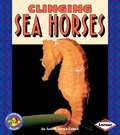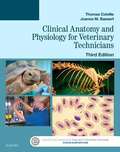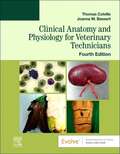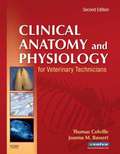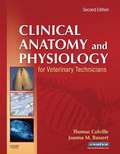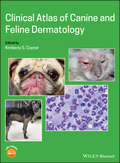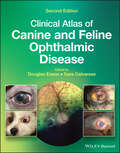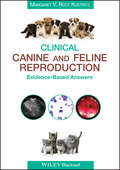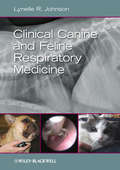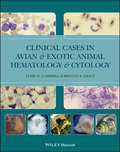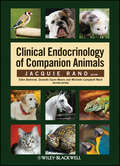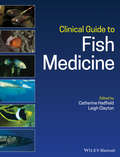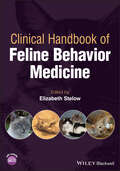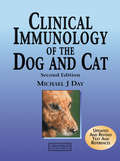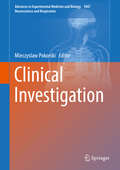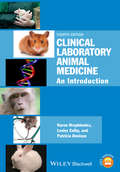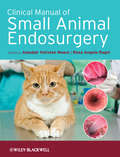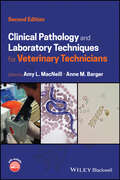- Table View
- List View
Climbing Tree Frogs
by Ruth BermanDo you know . . . * what is a frog, but does not look like a frog? * why tree frogs have sticky toes? * where tree frogs lay their eggs? * why male tree frogs call out? * how tree frogs drink water? * what tree frogs eat? Read this book and become an expert on tree frogs!
Clinging Sea Horses
by Judith Jango-CohenDo you know . . . * why sea horses cling? * where sea horses live? * how sea horses swim? * what sea horses eat? * how sea horses hide? * why some sea horses have a pouch? Read this book and become an expert on sea horses! Pull Ahead books are both fun and challenging. You'll want to read them all!
Clinical Anatomy and Physiology for Veterinary Technicians
by Joanna M. Bassert Thomas P. ColvilleExamine the diverse ways animal bodies function at both the systemic and cellular levels with this vital resource. It brings you clear coverage essential to understanding the clinical relevance of anatomical and physiological principles. Fully updated and written by respected veterinary technician educators, this popular textbook is the practical, comprehensive foundation for your success in veterinary technology. Clinical application boxes help you sharpen your skills and apply principles to practice. Test Yourself boxes throughout chapters emphasize important study points. An extensive glossary provides quick reference to hundreds of important terms and definitions. Over 300 new illustrations help you identify structures with rich, realistic clarity. A NEW full color format visually enhances your understanding of anatomic and physiologic concepts. Four NEW chapters give you the latest insight on the chemical basis of life, nutrition and metabolism, pregnancy, development, and lactation, and reptile and amphibian anatomy and physiology. A revised chapter on the cardiovascular system helps you most effectively comprehend the complex functions of the heart and blood vessels.
Clinical Anatomy and Physiology for Veterinary Technicians
by Joanna M. Bassert Thomas P. ColvilleStart your veterinary technician education off on the right foot with Clinical Anatomy and Physiology for Veterinary Technicians, 4th Edition. Combining expert clinical coverage with engaging writing and vivid illustrations, this popular text is the key to understanding the anatomic and physiologic principles that will carry you throughout your career. In addition to its comprehensive coverage of the diverse ways in which animal bodies function at both the systemic and cellular levels, this textbook features a variety of helpful application boxes, vocabulary lists, and Test Yourself questions in every chapter to ensure you have a firm grasp of anatomic structure and its relevance to clinical practice.
Clinical Anatomy and Physiology for Veterinary Technicians (2nd Edition)
by Joanna M. Bassert Thomas ColvilleExamine the diverse ways animal bodies function at both the systemic and cellular levels with this vital resource. It brings you clear coverage essential to understanding the clinical relevance of anatomical and physiological principles. Fully updated and written by respected veterinary technician educators, this popular textbook is the practical, comprehensive foundation for your success in veterinary technology. Clinical application boxes help you sharpen your skills and apply principles to practice. Test Yourself boxes throughout chapters emphasize important study points. An extensive glossary provides quick reference to hundreds of important terms and definitions. Over 300 new illustrations help you identify structures with rich, realistic clarity. A NEW full color format visually enhances your understanding of anatomic and physiologic concepts. Four NEW chapters give you the latest insight on the chemical basis of life, nutrition and metabolism, pregnancy, development, and lactation, and reptile and amphibian anatomy and physiology. A revised chapter on the cardiovascular system helps you most effectively comprehend the complex functions of the heart and blood vessels.
Clinical Anatomy and Physiology for Veterinary Technicians - Elsevier on VitalSource
by Joanna M. Bassert Thomas P. ColvilleClinical application boxes help you sharpen your skills and apply principles to practice.Test Yourself boxes throughout chapters emphasize important study points.An extensive glossary provides quick reference to hundreds of important terms and definitions.Over 300 new illustrations help you identify structures with rich, realistic clarity.A NEW full color format visually enhances your understanding of anatomic and physiologic concepts.Four NEW chapters give you the latest insight on the chemical basis of life, nutrition and metabolism, pregnancy, development, and lactation, and reptile and amphibian anatomy and physiology.A revised chapter on the cardiovascular system helps you most effectively comprehend the complex functions of the heart and blood vessels.
Clinical Atlas of Canine and Feline Dermatology
by Kimberly S. CoynerClinical Atlas of Canine and Feline Dermatology presents more than a thousand high-quality color photographs depicting common dermatologic diseases and conditions, making it easy for clinicians to quickly evaluate and accurately identify clinical dermatologic lesions. Easy-to-use charts of dermatologic diseases provide differential diagnoses and treatments, helping practitioners to quickly find the most common differential diagnoses, perform appropriate diagnostics, and treat their patients. Written by experienced veterinary dermatologists, the book begins with chapters on essential dermatologic diagnostics and identification and interpretation of skin lesions, featuring pictorial illustrations with commentary of the most common causes. Diagnostic algorithms for pruritus and alopecia simplify the workup of these very common presenting symptoms, and easily referenced tables detail the presentation, diagnosis, and management of hundreds of skin diseases. The book also offers a dermatologic formulary including systemic and topical therapies. Provides more than 1200 images showing the most encountered dermatologic conditions in dogs and cats Includes easy-to-interpret charts of differential diagnoses and treatments Offers diagnostic and treatment algorithms for the most common skin diseases in dogs and cats Presents details of the presentation, diagnosis, and management of hundreds of skin diseases in tables for quick reference Features video clips on a companion website demonstrating dermatologic diagnostic techniques, including skin scrapings and cytology, aspiration of skin masses for cytology, and biopsy Offering fast access to practical information for diagnosing and treating dermatologic disease in small animal practice, Clinical Atlas of Canine and Feline Dermatology is an essential book for any small animal practitioner or veterinary student.
Clinical Atlas of Canine and Feline Ophthalmic Disease
by Douglas W. EssonClinical Atlas of Canine and Feline Ophthalmic Disease provides an image-rich resource for diagnosing and treating ophthalmic conditions in clinical practice. * Presents more than 600 high-quality color photographs depicting commonly encountered ocular conditions in dogs and cats * Includes multiple images for each disease to show varying presentations * Organized for easy reference, covering the most commonly encountered conditions first * Designed for daily use in the busy clinical setting, allowing practitioners to quickly find and compare images as they see cases * Provides a concise summary of the most clinically relevant information on diagnosing and managing ophthalmic disease
Clinical Atlas of Canine and Feline Ophthalmic Disease
by Douglas W. Esson Sara CalvareseClinical Atlas of Canine and Feline Ophthalmic Disease Complete reference work for diseases and conditions in dogs and cats pertaining to the eye Clinical Atlas of Canine and Feline Ophthalmic Disease is a practical and user-friendly reference of common ocular diseases and conditions. Maintaining an image-heavy approach, the book presents multiple high-quality color photographs to depict each condition and is carefully organized to make it easy to find information. Sample topics included in the significantly expanded and updated new edition include: Basic ophthalmic anatomy & physiology Normal anatomical variations The ocular examination Basic ophthalmic pharmacology Diseases of the globe & orbit Diseases of the conjunctiva, nasolacrimal system & third eyelid Veterinary and animal science students, general canine and feline practitioners as well as interns, residents and specialists in a variety of areas can use this easily-accessible reference work to gain insight into a wide variety of ocular diseases affecting dogs and cats.
Clinical Atlas of Small Animal Cytology
by Andrew G. BurtonClinical Atlas of Small Animal Cytology provides an essential guide for interpreting cytologic samples to diagnose small animal patients. Features photographs of diseases with a diagnosis confirmed by pathognomonic cytologic features, histopathology, special stains, microbial culture, or other confirmatory tests Emphasizes characteristic features of each disease and distinguishing features Provides multiple images to differentiate cells from lesions that could look similar Presents more than 500 representative high-quality images
Clinical Atlas of Small Animal Cytology and Hematology
by Andrew G. BurtonClinical Atlas of Small Animal Cytology and Hematology A comprehensive image-based reference to all aspects of small animal cytology and hematology, including sample collection and handling Clinical Atlas of Small Animal Cytology and Hematology, Second Edition is an essential, comprehensive resource for all veterinary professionals preparing and evaluating cytology and blood samples. Featuring hundreds of large, high-quality images, this fully updated new edition provides an even more extensive collection of exceptional photomicrographs, accompanied by detailed descriptions, figure legends and annotations to guide readers through the diagnostic process. The Second Edition adds an extensive new hematology section, new chapters detailing sample acquisition and preparation, and many new diseases across all chapters. Each section provides a detailed description of the microscopic appearance, clinical considerations, and prognosis for each disease, using a bullet point format to promote rapid review for efficient, evidence-based clinical decision making. Clinical Atlas of Small Animal Cytology and Hematology features: More than 750 high-quality cytology and hematology images 6 new chapters, including detailed sections on sample acquisition and the preparation and staining of cytology and hematology slides A comprehensive hematology section including an easy-to-follow blood smear interpretation guide, and detailed chapters describing erythrocytes, leukocytes, platelets and background features Updated cytology sections with new diseases and images in all chapters Easy to use, with superior quality images and detailed yet succinct clinical information, Clinical Atlas of Small Animal Cytology and Hematology is a powerful resource to help improve confidence and skill in the interpretation of cytology and hematology samples, and in turn positively impact patient care and outcomes.
Clinical Canine and Feline Reproduction: Evidence-Based Answers
by Margaret V. Root KustritzClinical Canine and Feline Reproduction: Evidence-Based Answers provides quick, reliable answers to the most common questions in canine and feline reproductive and pediatric practice. Written using an innovative question-and-answer format, each answer is designed for quick reference, with the best references listed for further information as needed. Based on the author’s years of experience answering questions on reproduction and pediatrics, Clinical Canine and Feline Reproduction allows the practicing veterinarian to rapidly find and apply evidence-based answers from the scientific literature to their clinical questions.
Clinical Canine and Feline Respiratory Medicine
by Lynelle R. JohnsonClinical Canine and Feline Respiratory Medicine provides reliable information on the diagnosis and management of respiratory disease in a user-friendly format. With an emphasis on the features of the history and physical examination that aid in efficient diagnostic planning, the book is an accessible, readable resource for optimizing treatment of patients with diseases of the respiratory tract. Offering comprehensive, accessible coverage of respiratory disorders, Clinical Canine and Feline Respiratory Medicine is a useful practice guide and study aid for general practitioners and veterinary students.Beginning with introductory chapters on the localization of disease, diagnostics, and therapeutics, the heart of the book focuses on the full range of respiratory diseases, including nasal disorders, diseases of airways, parenchymal diseases, pleural and mediastinal diseases, and vascular disorders. Each chapter takes a common format with diseases subdivided by etiology into structural, infectious, inflammatory, and neoplastic disorders. Clinical Canine and Feline Respiratory Medicine is a useful tool for students and practitioners engaged in studying, diagnosing, and treating respiratory disease.
Clinical Cases in Avian and Exotic Animal Hematology and Cytology (Coursesmart Ser.)
by Terry Campbell Krystan R. GrantClinical Cases in Avian and Exotic Animal Hematology and Cytology demonstrates how to use hemic cytology and cytodiagnosis as part of the assessment of an exotic animal patient, taking the reader through nearly 100 actual clinical cases. With a focus on cytological interpretation, the hands-on, practical approach facilitates learning, teaching, and comprehension. Well illustrated throughout, Clinical Cases in Avian and Exotic Animal Hematology and Cytology is a helpful guide for exotics veterinarians, zoo and aquarium veterinarians, and veterinary hematologists.
Clinical Endocrinology of Companion Animals
by Michelle Campbell-Ward Jacquie Rand Danielle Gunn-Moore Ellen BehrendClinical Endocrinology of Companion Animals offers fast access to clinically relevant information on managing the patient with endocrine disease. Written by leading experts in veterinary endocrinology, each chapter takes the same structure to aid in the rapid retrieval of information, offering information on pathogenesis, signalment, clinical signs, diagnosis, differential diagnosis, treatment, prognosis, and prevention for a broad list of endocrine disorders. Chapters begin with brief summaries for quick reference, then delve into greater detail.With complete coverage of the most common endocrine diseases, the book includes chapters on conditions in dogs, cats, horses, ferrets, reptiles, and other species. Clinical Endocrinology of Companion Animals is a highly practical resource for any veterinarian treating these common diseases.
Clinical Guide to Fish Medicine
by Catherine A. Hadfield Leigh Ann ClaytonClinical Guide to Fish Medicine Designed as a practical resource, Clinical Guide to Fish Medicine provides an evidence-based approach to the veterinary care of fish. This guide—written and edited by experts in the field—contains essential information on husbandry, diagnostics, and case management of bony and cartilaginous fish.This important resource:Provides clinically relevant information on topics such as anatomy, water quality, life-support systems, nutrition, behavioral training, clinical examination, clinical pathology, diagnostic imaging, necropsy techniques, anesthesia and analgesia, surgery, medical treatment, and transportDescribes common presenting problems of fish, including possible differentials and practical approachesReviews key information on non-infectious and infectious diseases of fish in a concise format that is easily accessible in a clinical settingWritten for veterinarians, biologists, technicians, specialists, and students, Clinical Guide to Fish Medicine offers a comprehensive review of veterinary medicine of fish.
Clinical Handbook of Feline Behavior Medicine
by Elizabeth StelowClinical Handbook of Feline Behavior Medicine Comprehensive resource offering practical and accessible guidance on managing behavior problems in cats Clinical Handbook of Feline Behavior Medicine provides a complete, easy-to-use reference to practical information on identifying, diagnosing, and treating behavior problems in cats. Designed to offer streamlined access to concrete guidance for managing feline behavior, the book offers diagnostic plans organized by clinical sign. Normal behavior is thoroughly described, to provide a better understanding of the abnormal, with the heart of the book devoted to advice for identifying, diagnosing, and treating specific behavior problems. The book describes the diagnostic process and covers treatment options for each problem. A companion website offers client education handouts to enhance compliance and video clips depicting presenting complaints. Sample topics covered in Clinical Handbook of Feline Behavior Medicine include: Normal feline social behavior, covering body language and other social communication, feline social structure, interactions with humans and other species, and social/behavioral development in the kitten Preventing behavior problems, covering feeding, litter box availability and care, scratching options, toys, and grooming Elimination problems, including the differentiation between urine marking and toileting, deducing the underlying causes, and elements of effects treatment plans Senior cats, covering feline cognitive decline, increased vocalization, sleep-wake cycle disturbances, disorientation, litterbox problems, and repetitive behaviors With its specific topical focus of behavior in felines, Clinical Handbook of Feline Behavior Medicine is a targeted and highly useful resource for any veterinarian seeing feline patients, assisting through all stages of treatment with easily accessible and understandable information.
Clinical Immunology of the Dog and Cat
by Michael DayThis second edition of a bestseller details the manifestations, diagnosis and treatment of immune-related disease in the dog and cat. It is illustrated throughout in full color, to show and explain to the reader as clearly as possible the complicated principles of disease and immunodiagnostic tests, supported by clinical cases, gross and histopatho
Clinical Investigation (Advances in Experimental Medicine and Biology #1047)
by Mieczyslaw PokorskiClinical investigation plays an essential role in the differential diagnosis, biomarker development, and therapy and cure of diseases. The book presents a bench-to-bed approach, with broad empirical coverage by experienced practitioners. The articles include topics like cytokine receptors in lung cancer, conduciveness of oxidative stress to carcinogenesis, safety and effectiveness of surgical correction of deformed chest, diagnostic and treatment regimens in inflammation-ridden obstructive lung conditions, alterations in growth hormone secretion leading to disorders of growth and metabolism, microbiota transplantation in pediatric patients, and the promising markers of renal epithelial injury. Yet another issue concerns the restructuring of chronic pain management by establishing the community-based specialized pain clinics. The book aims to disseminate and deliberate on the latest interdisciplinary medical knowledge to enhance clinical outcomes. Being a blend of clinical investigation and practice the book is addressed to physicians, scientists, and allied health care professionals.
Clinical Laboratory Animal Medicine
by Patricia Denison Lesley A. Colby Karen HrapkiewiczClinical Laboratory Animal Medicine: An Introduction, Fourth Edition offers a user-friendly guide to the unique anatomy and physiology, care, common diseases, and treatment of small mammals and nonhuman primates. Carefully designed for ease of use, the book includes tip boxes, images, and review questions to aid in comprehension and learning. The Fourth Edition adds new information on transgenic mice, drug dosages, techniques, and environmental enrichment, making the book a comprehensive working manual for the care and maintenance of common laboratory animals.The book includes information on topics ranging from genetics and behavior to husbandry and techniques in mice, rats, gerbils, hamsters, guinea pigs, chinchillas, rabbits, ferrets, and nonhuman primates. A companion website provides editable review questions and answers, instructional PowerPoints, and additional images not found in the book. Clinical Laboratory Animal Medicine is an invaluable resource for practicing veterinarians, veterinary students, veterinary technicians, and research scientists.
Clinical Laboratory Animal Medicine: An Introduction
by Lesley A. Colby Megan H. Nowland Lucy H. KennedyThe revised fifth edition of Clinical Laboratory Animal Medicine: An Introduction is an accessible guide to basic information for conducting animal research safely and responsibly. It includes a review of the unique anatomic and physiologic characteristics of laboratory animals, husbandry practices, and veterinary care of many animals frequently used in research, including rodents, rabbits, ferrets, zebrafish, nonhuman primates, and agricultural animals. The updated fifth edition adds two new chapters on zebrafish and large animals, new information on transgenic models and genetic editing, and expanded coverage of environmental enrichment and pain management. The book presents helpful tip boxes, images, and review questions to aid in comprehension and learning, and a companion website provides editable review questions and answers, instructional PowerPoints, and additional images not found in the book. This important text: • Provides a complete introduction to laboratory animal husbandry, diseases, and treatments• Offers a user-friendly format with helpful content that highlights important concepts• Contains new knowledge relating to technical methodologies, diseases, drug dosages, laws and regulations, and organizations• Covers information on regulations, facilities, equipment, housing, and research variables as well as veterinary care• Includes new chapters on zebrafish and cattle, sheep, goats, and pigs Written for veterinary technicians, veterinary students, practicing veterinarians, and research scientists, the fifth edition of Clinical Laboratory Animal Medicine continues to offer an essential guide to the ethical treatment and anatomic and physiological characteristics of research animals.
Clinical Manual of Small Animal Endosurgery
by Alasdair Hotston Moore Rosa Angela RagniA practical and comprehensive guide to rigid endoscopy and endosurgery in small animal practice. Fully illustrated throughout, it covers the clinical treatment of small animals from pre-operative through to post-operative care. With reference to specific procedures, this manual includes guidance on the selection of equipment, surgical techniques, anaesthesia and possible complications. A specialist chapter advising on the treatment of birds, reptiles and small mammals is also included.Clinical Manual of Small Animal Endosurgery will enable veterinarians to develop and improve their endoscopic techniques in clinical practice, as well as providing guidance on referral options for more complex cases.KEY FEATURES* Provides comprehensive information on how to perform rigid endoscopic investigations and procedures.* The focus is on dogs and cats with a specialist chapter covering the treatment of exotic small animals* Contains many full colour clinical photographs* Written and edited by experts in the field
Clinical Medicine of the Dog and Cat
by Stuart Walton Michael Schaer Frédéric GaschenThe fourth edition of Clinical Medicine of the Dog and Cat remains the most extensively illustrated and practical small animal veterinary textbook on the market. It continues and expands on the revolutionary problem-based approach of the previous three editions, with more than 1,100 clinical color photographs, diagrams, and tables. The book is divided into five color-coded sections—General Approach, Diagnostic Techniques, Disease of Specific Organ Systems, Multisystemic Disorders, and Elements of Therapy. For this edition: Case studies are integrated within the relevant chapters for ease of reference. The first section on common medical problems now includes abdominal distension, peripheral edema, proteinuria, regurgitation, and seizures. Chapters on thoracic and abdominal radiographs are now included in a unique new section on Diagnostic Techniques, encouraging an integrated learning approach. The third section contains detailed medical information covering most organ systems, with several chapters completely rewritten and others comprehensively updated to include additional text and images. Additional endoscopic, radiographic, CT, and MRI images are included alongside clinical photographs; very few veterinary textbooks have such a rich emphasis on photographs. Each section has a limited number of recommended updated references. The practical information is presented with text, tables, and algorithms, while each chapter is arranged to provide the definition of each disorder, its clinical features, the differential diagnoses, the diagnostic methodology, and the treatment and prognosis. The formatting has been improved to make this textbook easy to read and comprehend. The busy veterinarian or student is thus provided with a readily available resource of important clinical information in a clear, brief manner. Written by board-certified experts, the topics are carefully selected to make this a valuable resource for veterinary students as well as for general practitioners and small animal interns.
Clinical Medicine of the Dog and Cat (Manson Ser.)
by Michael Schaer Frederic GaschenPrior to publication of the first edition of Clinical Medicine of the Dog and Cat, no other comprehensive small animal veterinary medicine book existed with a comparable amount of relevant illustrated material. This new third edition continues and expands on the revolutionary approach of the previous two editions, now including more than 1,850 highly valuable clinical colour photographs, diagrams, and tables. The third edition of this book has been completely revised and updated. The book is now divided into five color-coded sections – General Approach, Disease of Specific Organ Systems, Multisystemic Disorders, Elements of Therapy and Case Studies. As with the first and second editions of this book the overriding principle of succinct, yet comprehensive text presented in a clear format with an abundance of good quality images remains. Section I: General Approach is completely new and covers medical history and client communication, and common clinical problems. Section II: Specific Organ Systems is organized by body system with chapters structured in a systematic manner that include the definition for each disorder, its causes, clinical features, differential diagnoses, diagnostic methodology, treatment and prognosis, providing readers with easy access to important clinical information. New to this section are chapters covering diseases of the oral cavity and teeth, approach to thoracic radiographs, approach to abdominal radiographs, and disorders of hemostasis. Section III: Multisystemic Disorders covers revised and updated chapters including clinical toxicology, infectious diseases, and immunologic disorders. Section IV: Elements of Therapy covers therapies such as fluid therapy, pain management, nutrition of the critically ill dog and cat and a new chapter on management of the obese dog or cat. Section V: Case Studies includes over 25 case studies that enable the reader to relate the knowledge gained in the book to clinical cases seen in practice. Written by board-certified experts with several case contributions by clinicians in advanced phases of resident training, topics were carefully selected to make this a valuable resource to the general practitioner and also to small animal interns and veterinary students.
Clinical Pathology and Laboratory Techniques for Veterinary Technicians
by Anne M. Barger Amy L. MacNeillClinical Pathology and Laboratory Techniques for Veterinary Technicians Up-to-date, practical reference book demonstrating laboratory procedures in dogs, cats, cattle and horses The newly revised and updated Second Edition of Clinical Pathology and Laboratory Techniques for Veterinary Technicians is an inclusive reference on laboratory procedures pertaining to small animals, horses, and cattle, providing information on hematology, hemostasis, clinical chemistry, urinalysis, parasitology, endocrine testing, and quality assurance. The text clarifies ‘how-to’ information while also discussing the importance of ‘why’ laboratory procedures are performed in a particular way, enabling readers to gain true understanding of the topics discussed. To aid in reader comprehension, high-quality photographs labeled with magnification and stain information, which clearly depict cellular morphology, inclusions, and infectious organisms, are included throughout each chapter. The text also offers key objectives, technician tip boxes, case examples, and a glossary of key terms, along with a companion website that provides instructor questions, and an answer key to multiple choice questions in the book. Clinical Pathology and Laboratory Techniques for Veterinary Technicians includes information on: Sample collection, handling, and quality assurance, to ensure laboratory test results are validHematology data collection techniques that may be used on a daily basis to evaluate the overall health of animal patientsClinical chemistry data to indicate organ function, covering how different chemicals measured in patient samples relate to the function of specific organs in the bodyIn-house parasitology procedures, with important advances in molecular diagnostics have been made that improve the detection and identification of parasitesInformation about common endocrinopathies and submission of samples for endocrine testing. With complete coverage of the subject, Clinical Pathology and Laboratory Techniques for Veterinary Technicians is an essential resource for students enrolled in veterinary technology programs and veterinary colleges, and may be used as a textbook to guide and supplement information provided in both didactic and laboratory-based clinical pathology courses.

